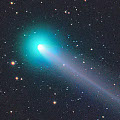
|
It passed only 0.4 A.U. from the earth, and 0.8 A.U. from the sun in November and December, and brightened up to 4.7 mag (Nov. 28, Juan Jose Gonzalez). Now it is 6.5 mag (Jan. 12, Marek Biely). In the Northern Hemisphere, it keeps observable in excellent condition for a long time until 2014 autumn when the comet will fade out. In the Southern Hemisphere, it is not be observable from mid November to early February.
Date(TT) R.A. (2000) Decl. Delta r Elong. m1 Best Time(A, h)
Jan. 18 17 55.48 12 46.7 1.340 0.950 45 7.0 3:23 (265,-16)
Jan. 25 18 4.09 10 13.5 1.419 1.022 46 7.6 3:33 (264, -9)
|
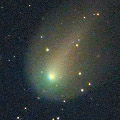
|
Although it was predicted to be 14 mag, it brightened up to 8 mag in outburst in mid October. After it became diffuse and faint, it turned to be brightening again. Now it is bright as 8.9 mag (Jan. 11, Katsumi Yoshimoto). It will be observable in excellent condition in spring. In the Northern Hemisphere, it will be getting higher gradually in the morning sky. In the Southern Hemisphere, it is not observable until February.
Date(TT) R.A. (2000) Decl. Delta r Elong. m1 Best Time(A, h)
Jan. 18 17 20.33 7 45.1 2.152 1.666 48 8.5 3:23 (265, -6)
Jan. 25 17 41.21 6 25.5 2.121 1.642 48 8.4 3:33 (264, -2)
|

|
It brightened very rapidly in mid November, from 15 mag to 9 mag only within a week. Now it is bright as 10.7 mag but diffuse (Jan. 4, Carlos Labordena). It seems to keep 10-11 mag for a while after this. It is observable in excellent condition in the Northern Hemisphere. It locates extremely low in the Southern Hemisphere.
Date(TT) R.A. (2000) Decl. Delta r Elong. m1 Best Time(A, h)
Jan. 18 11 22.92 43 31.4 0.938 1.756 132 11.3 3:23 (182, 12)
Jan. 25 11 24.50 46 46.3 0.979 1.812 134 11.5 3:09 (180, 8)
|

|
Now it is bright as 12.8 mag (Jan. 7, Taras Prystavski). It is expected to brighten up to 5-6 mag in 2014 autumn. In the Northern Hemisphere, it will be getting higher gradually after this, and it keeps observable in good condition for a long time. It keeps locating low in the Southern Hemisphere.
Date(TT) R.A. (2000) Decl. Delta r Elong. m1 Best Time(A, h)
Jan. 18 16 28.90 11 57.8 3.658 3.295 61 12.0 3:23 (254, 2)
Jan. 25 16 31.82 12 46.9 3.483 3.218 66 11.8 3:33 (248, 8)
|
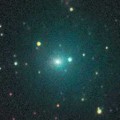
|
It brightened very rapidly, and brightened up to 10.5 mag from autumn to winter. It is bright as 11.8 mag still now (Dec. 29, J. P. Navarro Pina). It will be fading after this. In the Northern Hemisphere, it keeps observable in excellent condition until May when it becomes fainter than 18 mag. It will not be observable after this in the Southern Hemisphere.
Date(TT) R.A. (2000) Decl. Delta r Elong. m1 Best Time(A, h)
Jan. 18 0 30.60 23 22.1 1.526 1.658 79 11.9 20:56 (124, 6)
Jan. 25 0 49.81 25 11.7 1.590 1.678 77 12.2 20:50 (125, 4)
|

|
First return of a new periodic comet discovered in 1998. It brightened up to 10 mag at the discovery. Now it is 11.8 mag (Jan. 4, Marco Goiato). A bit fainter than originally expected. But in the Northern Hemisphere, it keeps observable in excellent condition from autumn to spring. It locates somewhat low in the Southern Hemisphere.
Date(TT) R.A. (2000) Decl. Delta r Elong. m1 Best Time(A, h)
Jan. 18 6 17.91 34 35.6 1.288 2.214 153 12.2 22:27 (180, 21)
Jan. 25 6 14.49 32 57.9 1.308 2.200 147 12.1 21:56 (180, 22)
|

|
Now it is 12.8 mag and visible visually (Dec. 5, Juan Jose Gonzalez). It keeps 13-14 mag and observable in good condition in the Northern Hemisphere for a long time from 2013 to 2014. In the Southern Hemisphere, it is not observable until 2014 autumn.
Date(TT) R.A. (2000) Decl. Delta r Elong. m1 Best Time(A, h)
Jan. 18 22 50.51 70 54.9 3.202 3.450 96 13.8 20:56 (157,-32)
Jan. 25 23 7.53 68 4.9 3.280 3.455 91 13.8 20:50 (154,-32)
|
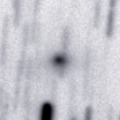
|
It brightened up to 2 mag by unusual major outburst in 2007. It is coming back now. It will be 14 mag at best by normal prediction. But actually, it is already very bright as 13.5 mag (Nov. 25, Hidetaka Sato). Now it is not observable. It will appear in the morning sky in May.
Date(TT) R.A. (2000) Decl. Delta r Elong. m1 Best Time(A, h)
Jan. 18 21 15.06 -16 29.9 3.035 2.125 18 13.9 20:56 ( 63, -8)
Jan. 25 21 29.66 -14 43.7 3.046 2.112 15 13.8 20:50 ( 64,-11)
|

|
It brightened up to 11-12 mag in 2012. Now it is 14.0 mag (Dec. 31, Taras Prystavski). It will be observable in good condition at 14 mag until 2014 early summer.
Date(TT) R.A. (2000) Decl. Delta r Elong. m1 Best Time(A, h)
Jan. 18 13 24.88 -14 36.4 6.870 6.983 92 13.9 3:23 (244, 54)
Jan. 25 13 22.28 -14 34.5 6.774 7.016 100 13.9 3:33 (232, 61)
|
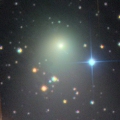
|
It became much brighter than expected, and reached up to 8.5 mag (Aug. 15, Alexandre Amorim). Now it is fading, but it is bright as 12.8 mag still now (Jan. 5, Taras Prystavski). In the Southern Hemisphere, it will keep observable in good condition for a long time until 2014 summer when the comet fades out. It will never be observable again in the Northern Hemisphere.
Date(TT) R.A. (2000) Decl. Delta r Elong. m1 Best Time(A, h)
Jan. 18 16 0.89 -66 55.8 2.884 2.527 59 14.0 3:23 (331, 39)
Jan. 25 16 18.51 -67 25.6 2.910 2.597 61 14.2 3:33 (332, 41)
|

|
Appearing in the morning sky. Now it is faint as 17.4 mag (Jan. 12, A. Maury, J. G Bosch, T. Noel, J.-F Soulier).
Date(TT) R.A. (2000) Decl. Delta r Elong. m1 Best Time(A, h)
Jan. 18 15 39.99 -28 24.6 6.623 6.170 58 14.0 3:23 (284, 34)
Jan. 25 15 43.98 -28 44.4 6.523 6.168 64 14.0 3:33 (280, 40)
|

|
Now it is 12.9 mag (Nov. 27, Sandor Szabo). It keeps bright at 13-14 mag for a long time until 2014. It keeps observable for a long time in the Northern Hemisphere, although it becomes unobservable temporarily in January. In the Southern Hemisphere, it keeps unobservable until March.
Date(TT) R.A. (2000) Decl. Delta r Elong. m1 Best Time(A, h)
Jan. 18 19 39.92 5 19.6 7.010 6.144 26 14.1 3:23 (289,-33)
Jan. 25 19 42.68 5 4.5 7.022 6.158 26 14.1 3:33 (283,-26)
|
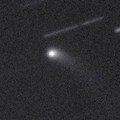
|
Now it is 14.2 mag and visible visually (Jan. 4, Chris Wyatt). It keeps 14 mag for a long time until 2014 summer. It keeps observable in good condition in the Northern Hemisphere. It is observable only until February in the Southern Hemisphere.
Date(TT) R.A. (2000) Decl. Delta r Elong. m1 Best Time(A, h)
Jan. 18 2 51.03 11 5.2 1.560 2.061 105 14.1 20:56 (144, 36)
Jan. 25 2 45.21 14 32.9 1.611 2.010 98 14.1 20:50 (139, 30)
|

|
It will pass the perihelion on Feb. 15, and will brighten up to 12 mag. Now it is not observable. It will appear in the evening sky in mid February in the Northern Hemisphere, or in early March in the Southern Hemisphere. Then it keeps observable while the comet will fade out very rapidly.
Date(TT) R.A. (2000) Decl. Delta r Elong. m1 Best Time(A, h)
Jan. 18 20 56.58 -14 52.7 1.714 0.804 14 15.1 20:56 ( 62,-12)
Jan. 25 21 30.91 -13 26.7 1.622 0.729 16 14.1 20:50 ( 65,-11)
|

|
Now it is 14.3 mag and visible visually (Dec. 25, Alan Hale). It is expected to brighten up to 7.5 mag and to be observable in excellent condition from summer to autumn in 2014 in the Southern Hemisphere. The condition is bad in the Northern Hemisphere. It will pass extremely close to Mars in 2014 October.
Date(TT) R.A. (2000) Decl. Delta r Elong. m1 Best Time(A, h)
Jan. 18 3 5.15 -37 13.4 3.674 3.803 89 14.3 20:56 ( 77, 69)
Jan. 25 2 57.52 -36 16.2 3.698 3.734 84 14.3 20:50 ( 78, 63)
|
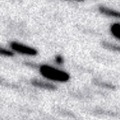
|
It reaches up to 12 mag in 2014 spring. But the condition in this apparition is bad. It locates low around the brightest days. Now it is 15.5 mag (Dec. 20, F. Garcia). It is already unobservable in the Southern Hemisphere. It will be unobservable in late January also in the Northern Hemisphere.
Date(TT) R.A. (2000) Decl. Delta r Elong. m1 Best Time(A, h)
Jan. 18 21 49.87 -8 42.4 2.890 2.089 29 14.5 20:56 ( 75, -6)
Jan. 25 22 4.67 -7 41.6 2.890 2.051 26 14.4 20:50 ( 75, -8)
|
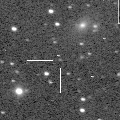
|
Already bright as 14.4 mag (Jan. 3, Mt. Lemmon Survey). It will brighten up to 13 mag and to be observable in excellent condition from spring to summer.
Date(TT) R.A. (2000) Decl. Delta r Elong. m1 Best Time(A, h)
Jan. 18 13 35.09 -11 22.5 2.555 2.761 91 14.6 3:23 (243, 50)
Jan. 25 13 42.35 -11 57.4 2.446 2.741 96 14.4 3:33 (235, 55)
|
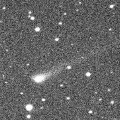
|
It keeps bright as 13-14 mag for a long time from 2013 to 2014. Now it is not observable. But it will appear in the morning sky again in 2014 February.
Date(TT) R.A. (2000) Decl. Delta r Elong. m1 Best Time(A, h)
Jan. 18 18 20.13 -26 35.6 3.954 3.075 23 14.8 3:23 (301, 2)
Jan. 25 18 32.33 -26 39.1 3.909 3.071 27 14.7 3:33 (298, 7)
|

|
Big asteroid discovered in 1906. It suddenly showed the cometary activity on Dec. 11, 2010, probably due to an impact of a small object. It has already turned to be stellar.
Date(TT) R.A. (2000) Decl. Delta r Elong. m1 Best Time(A, h)
Jan. 18 0 35.59 -7 26.4 3.458 3.221 67 15.0 20:56 (100, 26)
Jan. 25 0 41.74 -6 17.9 3.558 3.229 62 15.1 20:50 ( 99, 23)
|
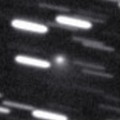
|
Now it is 14.8 mag (Dec. 31, Taras Prystavski). It keeps 15 mag until March, and will be observable in excellent condition in the Northern Hemisphere. It locates low in the Southern Hemisphere.
Date(TT) R.A. (2000) Decl. Delta r Elong. m1 Best Time(A, h)
Jan. 18 4 9.76 37 34.2 1.053 1.832 128 15.4 20:56 (172, 17)
Jan. 25 4 15.55 36 39.1 1.086 1.816 122 15.4 20:50 (169, 17)
|

|
It brightened up to 14.0 mag from spring to summer (June 11, Sandor Szabo). Now it is 15.4 mag, much brighter than origianlly predicted (Jan. 10, Ken-ichi Kadota). In the Northern Hemisphere, it will be observable at 15-16 mag in excellent condition until spring. It locates somewhat low in the Southern Hemisphere.
Date(TT) R.A. (2000) Decl. Delta r Elong. m1 Best Time(A, h)
Jan. 18 13 50.12 9 55.7 3.812 4.027 95 15.5 3:23 (228, 32)
Jan. 25 13 47.77 11 46.1 3.721 4.062 103 15.4 3:33 (217, 35)
|
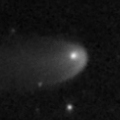
|
Now it is 14.6 mag (Dec. 29, Taras Prystavski). It will be fading after this, but it keeps brighter than 18 mag until 2015 spring.
Date(TT) R.A. (2000) Decl. Delta r Elong. m1 Best Time(A, h)
Jan. 18 3 6.18 -19 39.7 7.427 7.624 97 15.9 20:56 (118, 63)
Jan. 25 3 5.08 -18 47.0 7.557 7.657 92 15.9 20:50 (113, 58)
|
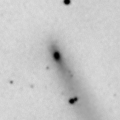
|
Now it is 15.6 mag (Jan. 9, Hidetaka Sato), brighter than origianlly predicted. It will be observable at 14-16 mag for a long time from 2013 to 2014.
Date(TT) R.A. (2000) Decl. Delta r Elong. m1 Best Time(A, h)
Jan. 18 15 42.08 -20 50.4 4.360 3.954 59 16.2 3:23 (276, 30)
Jan. 25 15 48.80 -21 20.8 4.278 3.964 65 16.1 3:33 (272, 36)
|
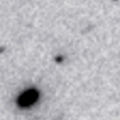
|
It is expected to brighten up to 13 mag and to be observable in good condition in 2015. Now it is 16.5 mag (Jan. 11, Ken-ichi Kadota). In 2014, it will be observable at 15 mag in good condition from winter to summer.
Date(TT) R.A. (2000) Decl. Delta r Elong. m1 Best Time(A, h)
Jan. 18 13 51.97 -4 51.3 5.145 5.236 89 16.2 3:23 (240, 42)
Jan. 25 13 54.93 -4 51.7 4.992 5.193 96 16.1 3:33 (231, 48)
|

|
It approached to the sun down to 0.73 A.U. on Mar. 24, and brightened up to 4.7 mag (Mar. 11, Michael Mattiazzo). Now it is fading. It has already faded down to 16.5 mag (Jan. 1, G. Dangl). In the Northern Hemisphere, it keeps observable in good condition while fading gradually. In the Southern Hemisphere, it will never be observable again.
Date(TT) R.A. (2000) Decl. Delta r Elong. m1 Best Time(A, h)
Jan. 18 20 13.25 49 56.1 4.532 4.307 70 16.3 20:56 (128,-50)
Jan. 25 20 21.26 50 34.4 4.625 4.381 69 16.4 3:33 (231,-50)
|
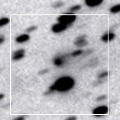
|
Now it is 15.4 mag (Dec. 30, Taras Prystavski). It tends to be brightest 4 months after the perihelion passage. It will reach up to 15.5 mag from autumn to winter, and will be observable in excellent condition.
Date(TT) R.A. (2000) Decl. Delta r Elong. m1 Best Time(A, h)
Jan. 18 5 57.81 21 2.3 1.468 2.381 151 16.3 22:06 (180, 34)
Jan. 25 5 55.20 21 30.7 1.547 2.415 144 16.5 21:36 (180, 33)
|

|
Now it is 16.3 mag (Dec. 31, Taras Prystavski). It keeps 16 mag for a long time until 2015 summer. It keeps observable in good condition in the Northern Hemisphere. It becomes observable only after 2015 in the Southern Hemisphere.
Date(TT) R.A. (2000) Decl. Delta r Elong. m1 Best Time(A, h)
Jan. 18 4 42.22 53 32.9 3.567 4.270 130 16.6 20:56 (179, 1)
Jan. 25 4 38.92 53 28.9 3.600 4.235 124 16.6 20:50 (176, 1)
|

|
Now it is 17.2 mag (Jan. 10, Ken-ichi Kadota). It brightens up to 15.5 mag from spring to summer, and will be observable in excellent condition in the Southern Hemisphere. It locates somewhat low in the Northern Hemispehre.
Date(TT) R.A. (2000) Decl. Delta r Elong. m1 Best Time(A, h)
Jan. 18 8 20.42 -22 38.9 1.801 2.603 136 16.9 0:33 (180, 78)
Jan. 25 8 15.22 -23 46.4 1.740 2.550 137 16.8 0:00 (180, 79)
|
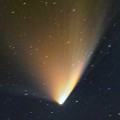
|
It passed the perihelion on Mar. 10, and brightened up to 0-1 mag. Now it is fading. It has already faded down to 15.6 mag (Jan. 7, Taras Prystavski). It will keep 16-17 mag until spring. It is not observable in the Southern Hemisphere.
Date(TT) R.A. (2000) Decl. Delta r Elong. m1 Best Time(A, h)
Jan. 18 17 8.32 26 52.9 5.165 4.798 62 16.8 3:23 (247,-14)
Jan. 25 17 12.12 27 25.1 5.182 4.873 66 16.9 3:33 (242, -9)
|
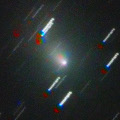
|
It brightened up to 9-10 mag in 2013 spring. Now it is fading. It has faded down to 15.8 mag in October (Oct. 7, Hidetaka Sato). In the Southern Hemisphere, it keeps observable for a long time until the comet fades out, although it keeps locating low. However, it has not been observed after November. It will never be observable again in the Northern Hemisphere.
Date(TT) R.A. (2000) Decl. Delta r Elong. m1 Best Time(A, h)
Jan. 18 16 49.01 -66 34.2 3.984 3.512 54 16.8 3:23 (332, 34)
Jan. 25 17 3.24 -66 55.1 4.006 3.580 57 16.9 3:33 (332, 36)
|

|
Now it is 17.3 mag (Jan. 11, Ken-ichi Kadota). It keeps close to the earth around 0.7 a.u. until spring. It will brighten up to 16.5 mag in February and March, and will be observable in excellent condition in the Northern Hemisphere. It locates very low in the Southern Hemisphere.
Date(TT) R.A. (2000) Decl. Delta r Elong. m1 Best Time(A, h)
Jan. 18 1 12.85 24 59.5 0.695 1.193 88 17.0 20:56 (132, 11)
Jan. 25 1 31.29 26 51.7 0.683 1.164 86 16.8 20:50 (133, 10)
|
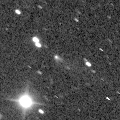
|
Now it is 17.4 mag (Jan. 4, Catalina Sky Survey). It keeps 17 mag for a long time from 2013 summer to early 2015.
Date(TT) R.A. (2000) Decl. Delta r Elong. m1 Best Time(A, h)
Jan. 18 1 53.08 13 5.8 2.834 3.053 93 17.0 20:56 (132, 27)
Jan. 25 1 58.75 13 25.0 2.927 3.048 87 17.1 20:50 (128, 24)
|

|
It brightened up to 12-13 mag from autumn to winter in 2012. Now it is fading. It has already faded down to 16.8 mag (Dec. 23, J. Lozano). It keeps observable for a long time until March when the comet becomes fainter than 18 mag.
Date(TT) R.A. (2000) Decl. Delta r Elong. m1 Best Time(A, h)
Jan. 18 5 37.09 -2 25.1 4.132 4.911 138 17.1 21:46 (180, 57)
Jan. 25 5 34.97 -2 23.0 4.240 4.957 132 17.2 21:16 (180, 57)
|

|
Fading rapidly. Now it is 15.7 mag (Jan. 5, Taras Prystavski). However, the central nucleus is so faint as 19.0 mag (Jan. 12, Martin Masek). It locates high in the Southern Hemisphere. But it will be too faint to observe soon. It locates extremely low in the Northern Hemisphere.
Date(TT) R.A. (2000) Decl. Delta r Elong. m1 Best Time(A, h)
Jan. 18 13 27.27 -41 29.5 2.366 2.434 82 17.1 3:23 (294, 63)
Jan. 25 13 29.11 -43 43.8 2.360 2.510 87 17.4 3:33 (302, 69)
|
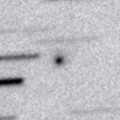
|
Now it is 16.6 mag (Jan. 7, Toshiyuki Takahashi). It is expected to brighten up to 6 mag in 2014 autumn. At this time, it keeps observable while brightening gradually until April when it becomes 16 mag.
Date(TT) R.A. (2000) Decl. Delta r Elong. m1 Best Time(A, h)
Jan. 18 6 0.75 22 23.8 2.970 3.870 152 17.2 22:09 (180, 33)
Jan. 25 5 48.56 22 6.2 2.960 3.790 142 17.1 21:29 (180, 33)
|

|
Now it is 17.2 mag (Jan. 12, P. C. Sherrod). It will approach to the earth down to 0.68 a.u., brighten up to 16 mag, and will be observable in excellent condition in spring.
Date(TT) R.A. (2000) Decl. Delta r Elong. m1 Best Time(A, h)
Jan. 18 12 33.78 32 26.3 1.127 1.814 118 17.4 3:23 (198, 20)
Jan. 25 12 35.89 31 37.0 1.046 1.788 123 17.2 3:33 (191, 23)
|
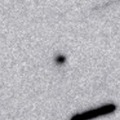
|
Now it is 17.8 mag (Jan. 8, K. Hills). It keeps 15-16 mag for a long time from 2015 to 2016. In this winter, it is observable at 17.5 mag until March.
Date(TT) R.A. (2000) Decl. Delta r Elong. m1 Best Time(A, h)
Jan. 18 2 52.07 -3 31.8 6.682 6.940 101 17.5 20:56 (133, 49)
Jan. 25 2 51.19 -2 48.2 6.760 6.907 94 17.5 20:50 (128, 45)
|
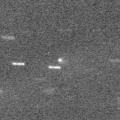
|
Now it is 18.3 mag (Jan. 6, Toshiyuki Takahashi). In this winter, it is observable at 17.5 mag in good condition until March.
Date(TT) R.A. (2000) Decl. Delta r Elong. m1 Best Time(A, h)
Jan. 18 10 57.63 10 6.5 1.695 2.496 135 17.6 3:10 (180, 45)
Jan. 25 10 55.67 10 16.2 1.653 2.512 143 17.6 2:40 (180, 45)
|

|
It keeps 17-18 mag for a long time from 2013 to 2014. It is observable in excellent condition in the Southern Hemisphere. It is not observable in the Northern Hemisphere.
Date(TT) R.A. (2000) Decl. Delta r Elong. m1 Best Time(A, h)
Jan. 18 14 42.15 -44 22.4 4.978 4.701 68 17.7 3:23 (300, 49)
Jan. 25 14 41.17 -45 55.1 4.867 4.696 74 17.7 3:33 (302, 56)
|

|
It was expected to be a great comet as it approached to the sun down to only 0.01 A.U. on Nov. 28. It brightened up to -2.5 mag at best. However, the comet's nucleus disrupted at the perihelion passage. After that, the dust remnant had been visible until Dec. 6 on the STEREO spacecraft images. However, the dust remnant has not been detected by CCD observations on the ground. The nucleus is not detected, fainter than 18 mag (Dec. 13, Lorenzo Comolli). But visual observers reported it was visible at 7.5 mag on Dec. 6 (Piotr Guzik), 7.2 mag on Dec. 7 (Juan Jose Gonzalez), and 9.6 mag on Dec. 9 (Jakub Cerny). It approached to the earth down to 0.4 A.U. from mid December to early January, but it was not detected. It is not observable in the Southern Hemisphere.
Date(TT) R.A. (2000) Decl. Delta r Elong. m1 Best Time(A, h)
Jan. 18 3 48.13 70 23.3 0.738 1.485 118 17.8 20:56 (175,-15)
Jan. 25 4 3.35 62 41.3 0.909 1.621 117 19.0 20:50 (173, -8)
|

|
Now it is 17.4 mag (Jan. 15, A. Hidas). It is expected to brighten up to 14 mag from autumn to winter in 2015. The condition is excellent in the Southern Hemisphere, and it keeps observable for a long time after this while the comet will be brightening. In the Northern Hemisphere, it will be unobservable in late March.
Date(TT) R.A. (2000) Decl. Delta r Elong. m1 Best Time(A, h)
Jan. 18 5 44.53 -39 2.6 5.856 6.299 112 17.8 21:52 ( 0, 86)
Jan. 25 5 37.00 -38 14.7 5.851 6.257 110 17.8 21:18 ( 0, 87)
|
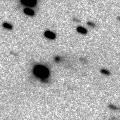
|
Now it is 16.7 mag (Jan. 3, Catalina Sky Survey). It will be fading after this.
Date(TT) R.A. (2000) Decl. Delta r Elong. m1 Best Time(A, h)
Jan. 18 2 52.73 15 47.6 2.126 2.602 107 17.8 20:56 (147, 32)
Jan. 25 2 58.45 15 59.1 2.216 2.606 102 18.0 20:50 (143, 30)
|

|
Now it is 18.2 mag (Dec. 26, A. Diepvens). It will approach to the earth down to 0.06 a.u. from May to June, and it is expected to brighten up to 11 mag. In the Northern Hemisphere, it keeps observable in excellent condition until the highlight in late May while the comet will be brightening rapidly. In the Southern Hemisphere, it is not observable now. But it will be observable in mid May. Then it keeps observable in excellent condition at the highlight and after that while the comet will be fading.
Date(TT) R.A. (2000) Decl. Delta r Elong. m1 Best Time(A, h)
Jan. 18 9 18.06 57 33.6 0.826 1.703 140 18.0 1:31 (180, -2)
Jan. 25 9 10.11 61 9.5 0.774 1.640 137 17.9 0:56 (180, -6)
|

|
Now it is 17.9 mag (Dec. 8, Hidetaka Sato). It will brighten up to 14 mag around the perihelion passage in 2019. In 2013, it will be observable in good condition at 18 mag from summer to winter. It locates low in the Southern Hemisphere.
Date(TT) R.A. (2000) Decl. Delta r Elong. m1 Best Time(A, h)
Jan. 18 2 41.67 27 0.7 13.135 13.477 108 17.9 20:56 (150, 21)
Jan. 25 2 41.36 27 1.6 13.221 13.449 101 17.9 20:50 (146, 19)
|

|
It keeps 18 mag for a very long time from 2013 to 2018. It locates high in the Southern Hemisphere. But it locates somewhat low in the Northern Hemisphere.
Date(TT) R.A. (2000) Decl. Delta r Elong. m1 Best Time(A, h)
Jan. 18 11 17.25 -19 16.2 8.898 9.388 117 18.0 3:23 (185, 74)
Jan. 25 11 16.38 -19 24.4 8.801 9.382 123 17.9 3:01 (180, 74)
|
|
![]()
 C/2013 A1 ( Siding Spring )
C/2013 A1 ( Siding Spring ) 4P/Faye
4P/Faye 134P/Kowal-Vavrova
134P/Kowal-Vavrova 117P/Helin-Roman-Alu 1
117P/Helin-Roman-Alu 1 (596) Scheila
(596) Scheila 52P/Harrington-Abell
52P/Harrington-Abell C/2012 K6 ( McNaught )
C/2012 K6 ( McNaught ) C/2009 F4 ( McNaught )
C/2009 F4 ( McNaught ) P/2012 B1 ( PanSTARRS )
P/2012 B1 ( PanSTARRS ) C/2012 F3 ( PanSTARRS )
C/2012 F3 ( PanSTARRS ) C/2012 F6 ( Lemmon )
C/2012 F6 ( Lemmon ) 84P/Giclas
84P/Giclas C/2013 V2 ( Borisov )
C/2013 V2 ( Borisov ) C/2013 Y2 ( PanSTARRS )
C/2013 Y2 ( PanSTARRS ) C/2011 L4 ( PanSTARRS )
C/2011 L4 ( PanSTARRS ) C/2012 L2 ( LINEAR )
C/2012 L2 ( LINEAR ) P/2013 TL117 ( Lemmon )
P/2013 TL117 ( Lemmon ) 119P/Parker-Hartley
119P/Parker-Hartley C/2012 J1 ( Catalina )
C/2012 J1 ( Catalina ) C/2013 N4 ( Borisov )
C/2013 N4 ( Borisov ) C/2013 V5 ( Oukaimeden )
C/2013 V5 ( Oukaimeden ) 124P/Mrkos
124P/Mrkos C/2013 V4 ( Catalina )
C/2013 V4 ( Catalina ) 266P/2012 P1 ( Christensen )
266P/2012 P1 ( Christensen ) C/2013 G7 ( McNaught )
C/2013 G7 ( McNaught ) C/2012 S1 ( ISON )
C/2012 S1 ( ISON ) C/2014 A4 ( SONEAR )
C/2014 A4 ( SONEAR ) 291P/2013 N2 ( NEAT )
291P/2013 N2 ( NEAT ) 209P/LINEAR
209P/LINEAR C/2010 U3 ( Boattini )
C/2010 U3 ( Boattini ) C/2013 C2 ( Tenagra )
C/2013 C2 ( Tenagra )![]()







































